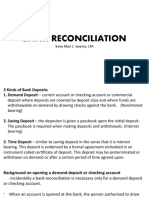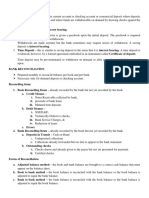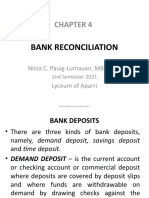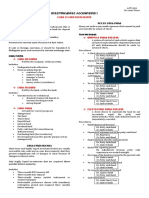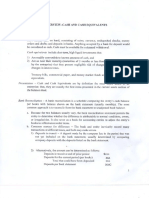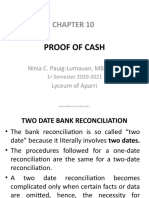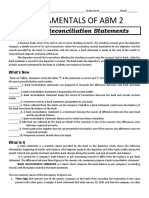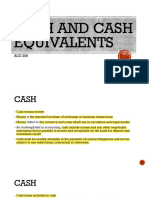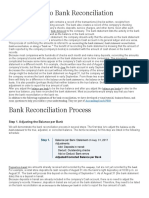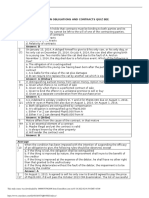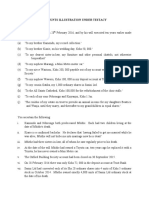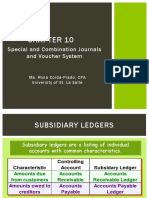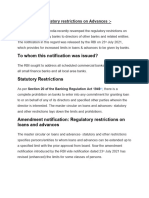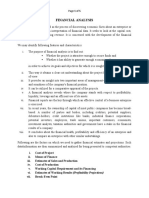Intermediate Accounting 1 Module For Midterm Part 1
Uploaded by
trixiakalawIntermediate Accounting 1 Module For Midterm Part 1
Uploaded by
trixiakalawIntermediate Accounting, I|| Module Content || Prelim
Course Intermediate Accounting Volume 1, deals with the accounting of all the assets
Description (CD) account for Statement of Financial Positions.
Course Learning At the end of the course, BSA students should be able to:
Outcomes (CLO)
1. Understand the concept of assets
2. Understand the classification and measurement of all the asset accounts.
3. Identify the items considered as assets
Evidence of To assess the students acquired competencies and/or learning outcomes, the
Learning/ teacher will facilitate the following assessment:
Assessment
Tools 1. Problem solving
2. Socratic questioning
3. Quiz
Module All activities must be written in a separate paper and to be submitted upon the
requirements collection of the modular learning sheets. You may also opt to submit your output
submission via email or messenger if you will have the chance to access the internet (please
instructions check your timeline for guidance).
Topics For the course/subject following are the topics to be discussed:
(Coverage)
1. Assets considered as current
2. Assets considered as non current
This course is offered to the first year students taking up Bachelor of Science in
Target Accountancy and Bachelor of Science in Accounting Information System.
Participants
Learning time refers to the duration of the course being taken by the students.
Learning Time:
Academic Year 2020-2021, Second Semester
February - June 2021
Means for
Learner Support
CARD-MRI Development Institute, Inc. Modular Learning Page 1 of 5
Intermediate Accounting, I|| Module Content || Prelim
Icon used in the Modular Learning Packets
Activation of your prior knowledge icon.
These include introduction of the topic and preliminary activities and/or exercises (not graded)
Acquisition of new knowledge icon.
This is the learning part of the module where content about the topic/lesson is being discussed.
Acquisition of new knowledge icon (for online references transcription)
This is the learning part of the module where other learning tools such as video or e-books about
the topic/lesson is being discussed.
Application of acquired knowledge and/or competency icon.
This learning part of the module where the acquired competency and knowledge will be practiced
(may be graded or not)
Assessment of acquired knowledge and/or competency icon.
This learning part of the module where the acquired competency and knowledge will be evaluated
through different assessment activities (may be graded or not)
Resources icon.
This part of the module provided other additional reading materials and/or references for the
student to use in their self-paced learning.
Timeline icon.
This part of the module indicates the activity timeline as guide for the students (instructions,
submissions dates and other announcements).
Rubrics icon.
This part of the module indicates how the student activities will be graded.
*Icons designed by Ms. Lorelie F. Aguilar using Icon maker
CARD-MRI Development Institute, Inc. Modular Learning Page 2 of 5
Intermediate Accounting, I|| Module Content || Prelim
Chapter 2 – Bank Recon
Week 4
Let’s activate your prior knowledge!
(Time allotted: 10 minutes)
How do you understand the word “Bank Recon”
Now, let’s acquire new knowledge!
(Time allotted: 60 minutes)
Bank reconciliation
A bank reconciliation is a statement which brings into agreement the cash balance per book and
cash balance per bank.
The reconciliation is usually prepared monthly because the bank provides the depositor with the
bank statement at the. end of every month:
A bank statement is a monthly report of the bank to the depositor showing:
a. The cash balance per bank at the beginning
b. The deposits made by the depositor and acknowledged by the bank
c. The checks drawn by the depositor and paid by the bank
d. The daily cash balance per bank during the month
Actually, the bank statement is an exact copy of the depositor's ledger in the records of the
bank.
When the bank statement is received, attached thereto are the depositor's canceled checks and
any debit or credit memoranda that have affected the depositor's account.
The canceled checks are the checks issued by the depositor and paid by the bank during the
month.
These are called canceled checks because they are literally canceled by stamping or punching
to show that they have been paid.
Reconciling items
CARD-MRI Development Institute, Inc. Modular Learning Page 3 of 5
Intermediate Accounting, I|| Module Content || Prelim
At the end of every month, comparison between the cash records of the depositor and the bank
statement received from the bank will yield the following reconciling items:
1. Book reconciling items:
a) Credit memos
b) Debit memos
c) Errors
2. Bank reconciling items
a) Deposits in transit
b) Outstanding checks
c) Errors
Credit memos
Credit memos refer to items not representing deposits credited by the bank to the account of
the depositor but not yet recorded by the depositor as cash receipts.
The credit memos have the effect of increasing the bank balance.
Typical examples of credit memos are:
a. Notes receivable collected by bank in favor of the depositor and credited to the account of
the depositor.
b. Proceeds of bank loan credited to the account of the depositor
c. Matured time deposits transferred by the bank to the current account of the depositor.
Debit memos
Debit memos refer to items not representing checks paid by bank which are charged or debited
by the bank to the account of the depositor but not yet recorded by the depositor as cash
disbursements. The debit memos have the effect of decreasing the bank balance.
Typical examples of debit memos are:
a. NSF or no sufficient fund checks — These are checks deposited but returned by the bank
because of insufficiency of fund. The other name for NSF is DAM or "drawn against insufficient
fund".
b. Technically defective checks — These are checks deposited but returned by the bank because
of technical defects such as absence of signature or countersignature, erasures not
countersigned, mutilated checks, conflict between amount In words and amount in figures.
CARD-MRI Development Institute, Inc. Modular Learning Page 4 of 5
Intermediate Accounting, I|| Module Content || Prelim
c. Bank service charges — These include bank charges for interest, collection, checkbook and
penalty.
d. Reduction of loan — This pertains to amount deducted from the current account of the
depositor in payment for loan which the depositor owes to the bank and which has already
matured.
Deposits in transit
Deposits in transit are collections already recorded by the depositor as cash receipts but not yet
reflected on the bank statement.
Deposits in transit include:
a. Collections already forwarded to the bank for deposit but too late to appear in the bank
statement.
b. Undeposited collections or those still in the hands of the depositor. In effect, these are cash
on hand awaiting delivery to the bank for deposit.
Outstanding checks
Outstanding checks are checks already recorded by the depositor as cash disbursements but not
yet reflected on the bank statement.
Outstanding checks include:
a. Checks drawn and already given to payees but not yet presented for payment.
b. Certified checks — A certified check is one where the bank .has stamped on its face the word
"accepted" or "certified" indicating sufficiency of fund.
When the bank certifies a check. the account of the depositor is immediately debited or charged
to insure the eventual payment of the check.
Certified checks should be deducted from the total outstanding checks if included therein)
because they are no longer outstanding for bank reconciliation purposes.
Forms of bank reconciliation
The following formats may be used in reconciling the book balance and the bank balance:
a. Adjusted balance method — Under this method, the book balance and the bank balance are
brought to a correct cash balance that must appear on the balance sheet.
b. Book to bank method — Under this method, the book balance is reconciled with the bank
balance or the book balance is adjusted to equal the bank balance.
CARD-MRI Development Institute, Inc. Modular Learning Page 5 of 5
Intermediate Accounting, I|| Module Content || Prelim
c. Bank to book method — Under this method, the bank balance is reconciled with the book
balance or the bank balance is adjusted to equal the book balance.
The first method is preferred over the other two.
Proforma reconciliation
Adjusted balance method
Book balance
Add: Credit memos
Total
Less: Debit memos
Adjusted book balance
Bank balance
Add: Deposits in transit
Total
Less: Outstanding checks
Adjusted bank balance
The reconciling items of the book are simply termed as credit memos and debit memos.
No details are shown to simplify the illustration.
In actual formal reconciliation, details will have to be shown.
Moreover, errors are excluded because no definite rule can be made whether these are to be
added or deducted.
Errors will have to be analyzed for proper treatment.
However, errors are reconciling items of the party which committed them.
It will be observed that under the adjusted balance method, the credit memos are always added
to the book balance and the debit memos are always deducted from the book balance.
Deposits in transit are always added to the bank balance and the outstanding checks are always
deducted from the bank balance.
CARD-MRI Development Institute, Inc. Modular Learning Page 6 of 5
Intermediate Accounting, I|| Module Content || Prelim
Explanation
The foregoing procedures can be explained as follows:
The adjusted balance method means that the book balance and the bank balance are adjusted
to equal the correct cash balance.
Credit memos already increased the bank balance but have no effect on the book balance
because the credit memos are not yet recorded by the depositor.
Consequently, the book balance is understated in relation to the correct cash balance.
Hence, credit memos are added to the book balance.
Debit memos already decreased the bank balance but have no effect on the book balance
because the debit memos are not yet recorded by the depositor.
Consequently, the book balance is overstated in relation to the correct cash balance.
Hence, debit memos are deducted from the book balance.
Deposits in transit already increased the book balance but have no effect on the bank balance
because the deposits are not yet recorded by the bank.
Consequently, the bank balance is understated in relation to the correct cash balance.
Hence, deposits in transit are added to the bank balance.
Outstanding checks already decreased the book balance but have no effect on the bank balance
because the checks are not yet paid by the bank.
Consequently, the bank balance is overstated in relation to the correct cash balance.
Hence, outstanding checks are deducted from the bank balance.
CARD-MRI Development Institute, Inc. Modular Learning Page 7 of 5
Intermediate Accounting, I|| Module Content || Prelim
CARD-MRI Development Institute, Inc. Modular Learning Page 8 of 5
Intermediate Accounting, I|| Module Content || Prelim
CARD-MRI Development Institute, Inc. Modular Learning Page 9 of 5
Intermediate Accounting, I|| Module Content || Prelim
General procedures in preparing the reconciliation
a. Determine the balance per book and the balance per bank.
As mentioned earlier, the cash in bank account on the book of the depositor has a debit balance
of P50,000.
The bank balance is shown on the bank statement as the final item, P84,000.
b. Trace the cash receipts to the bank statement to ascertain whether there are deposits not
yet acknowledged by the bank.
In the illustrative problem, the cash receipt of P40,000 on January 31 does not appear in the
bank statement. This represents deposit in transit.
c. Trace the checks issued to the bank statement to ascertain whether there are checks not yet
presented for payment.
In the illustrative problem, Check Nos. 725 for P37,000 and 726 for P28,000 do not appear in
the bank statement. These are outstanding checks.
d. The bank statement should be examined to determine whether there are bank credits or bank
debits not yet recorded by the depositor.
In the illustrative problem there is CM of P15,000 and. DM for returned check of P5,000 and
service charge of P1,000.
e. Watch out for errors. Again, errors are reconciling items of the party which committed them.
In the illustrative problem, there are no errors committed.
At this point, a formal reconciliation may be prepared because all the reconciling items have
already been determined.
CARD-MRI Development Institute, Inc. Modular Learning Page 10 of 5
Intermediate Accounting, I|| Module Content || Prelim
CARD-MRI Development Institute, Inc. Modular Learning Page 11 of 5
Intermediate Accounting, I|| Module Content || Prelim
CARD-MRI Development Institute, Inc. Modular Learning Page 12 of 5
Intermediate Accounting, I|| Module Content || Prelim
Some errors and their correction
a. Understatement of cash receipts on the book of depositor.
For example, the collection from customer which is deposited amounts to P10,000 but recorded
in the book only as P1,000.
There is an understatement of cash receipt of P9,000. The error is added to the book balance
and adjusted as follows: •
Cash in bank 9,000
Accounts receivable 9,000
b. Understatement of checks drawn by depositor.
For example, a check in payment of account payable amounting to P20,000 is recorded in the
book as P2,000.
There is an understatement of cash disbursement and a consequent overstatement of book
balance in the amount of P18,000. The error is deducted from the book balance and adjusted,
as follows:
Accounts payable 18,000
Cash in bank 18,000
c. Deposit of another entity is credited by the bank to the account of the depositor.
This is a deduction from the bank balance because it erroneously increased the account balance
of the depositor in the bank. No adjustment is necessary on the book of the depositor.
d. Check of another entity charged to the account of the depositor.
This is an addition to the bank balance because it erroneously decreased the account balance
of the depositor in the bank. No adjustment is necessary on the book of the depositor.
CARD-MRI Development Institute, Inc. Modular Learning Page 13 of 5
Intermediate Accounting, I|| Module Content || Prelim
Chapter 4 – Accounts Receivable
Week4 Continuation
Classification
Trade receivables which are expected to be realized in cash within the normal operating cycle
or one year, whichever is longer, are classified as current assets. .
Nontrade receivables which are expected to be realized in cash within one year, the length of
the operating cycle notwithstanding, are classified as current assets.
If collectible beyond one year, nontrade receivables are classified as noncurrent assets.
The classifications are in accordance with PM 1, Presentation of Financial Statements, paragraph
66, which states:
"An entity shall classify an asset as current when the entity expects to realize the asset or intends
to sell or consume it in the entity's normal operating cycle, or when the entity expects to realize
the asset within twelve months after the reporting period."
Presentation
Trade receivables and nontrade receivables which are currently collectible shall be presented on
the face of the statement of financial position as one line item called trade and other receivables.
However, the details of the total trade and other receivables shall be disclosed in the notes to
financial statements.
For example, the disclosure may appear as follows:
Accounts receivable 5,000,000
Allowance for doubtful accounts ( 200,000)
Notes receivable 1,000,000
Accrued interest on note receivable 150,000
Advances to officers and employees 100,000
Dividends receivable 250,000
CARD-MRI Development Institute, Inc. Modular Learning Page 14 of 5
Intermediate Accounting, I|| Module Content || Prelim
Total trade and other receivables 6,300,000
Examples of nontrade receivables
a. Advances to or receivables from shareholders, directors, officers or employees. If
collectible in one year, such advances or receivables should be classified as current assets.
Otherwise, such advances or receivables are classified as noncurrent assets.
b. Advances to affiliates are usually treated as long-term investments.
c. Advances to supplier for the acquisition of merchandise are current assets.
d. Subscriptions receivable are current assets if collectible within one year. Otherwise,
subscriptions receivable should be shown preferably as a deduction from subscribed share
capital.
e. Creditors accounts may have debit balances as a result of overpayment or returns and
allowances. These are classified as current assets.
If the debit balances are not material, an offset may be made against the creditors
accounts with credit balances and only the net accounts payable may be presented.
f. Special deposits on contract bids normally are classified as noncurrent assets because
such deposits are likely to remain outstanding for a considerable long period of time.
However, the deposits that are collectible currently should be classified as current assets.
g. Accrued income such as dividend receivable, accrued rent receivable, accrued royalties
receivable and accrued interest receivable on bond investment are usually classified as current
assets.
h. Claims receivable such as claims against common carriers for losses or damages: claim for
rebates and tax refunds, claim from insurance entity, are normally classified as current assets.
CARD-MRI Development Institute, Inc. Modular Learning Page 15 of 5
Intermediate Accounting, I|| Module Content || Prelim
Net realizable value
The initial amount recognized for accounts receivable shall be reduced by adjustments which in
the ordinary course of business will reduce the amount recoverable from the customer
This is based on the established basic principle that assets shall not be carried at above their
recoverable amount.
Accordingly, in estimating the net realizable value of trade accounts receivable, the following
deductions are made:
a. Allowance for freight charge
b. Allowance for sales return
c. Allowance for sales discount
d. Allowance for doubtful accounts
Terms related to freight charge
In order to give proper accounting recognition to freight charge in relation to accounts
receivable, the following terms should be understood — FOB destination, FOB shipping point,
freight collect and freight prepaid.
The term FOB destination means that ownership of the goods purchased is vested in the buyer
upon receipt thereof.
Accordingly, the seller shall be responsible for the freight charge up to the point of destination.
The term FOB shipping point means that ownership of the goods purchased is vested in the
buyer upon shipment thereof.
Thus, it is incumbent upon the buyer. to pay for the transportation charge from the point of
shipment to the point of destination.
The term freight collect means that freight charge on the goods shipped is not yet paid. The
common carrier shall collect the same from the buyer. Thus, under this, the freight charge is
actually paid by the buyer.
CARD-MRI Development Institute, Inc. Modular Learning Page 16 of 5
Intermediate Accounting, I|| Module Content || Prelim
The term freight prepaid means that freight charge on the goods shipped is already paid by the
seller.
Accounting for bad debts
Business entities sell on credit rather than only for cash to increase total sales and thereby
increase income.
However, an entity that sells on credit assumes the risk that some customers will not pay their
accounts.
When an account becomes uncollectible, the entity has sustained a bad debt loss. This loss is
simply one of the costs of doing business on credit.
Two methods are followed in accounting for this bad debt loss, namely:
1. Allowance method 2.
2. Direct writeoff method
Allowance method
The allowance method requires recognition of a bad debt loss if the accounts are doubtful of
collection. The journal entry to recognize the doubtful accounts is:
Doubtful accounts
Allowance for doubtful accounts
The "allowance for doubtful accounts" is deduction from accounts receivable.
If the doubtful accounts are subsequently found to be worthless or uncollectible, the accounts
are written off as follows:
Allowance for doubtful accounts
Accounts receivable
Generally accepted accounting principles require the use of the allowance method because it
conforms with the matching principle.
Moreover, accounts receivable would be properly measured at net realizable value.
CARD-MRI Development Institute, Inc. Modular Learning Page 17 of 5
Intermediate Accounting, I|| Module Content || Prelim
Recoveries of accounts written off
If collection is made on account previously written off as uncollectible, the customary procedure
is first to recharge the customer's account with the amount collected and possibly with the entire
amount previously charged off if it is now expected that collection will be received in full.
The collection is then recorded normally by debiting cash and crediting accounts receivable.
The recharging of the customer's account is usually followed because it is an evidence of the
attempt of the customer to reestablish his credit with the entity.
What account should be credited when the customer's account is recharged?
The generally accepted approach is to simply reverse the original entry of writeoff regardless of
whether the recovery is during the year of writeoff or subsequent thereto.
Illustration - Allowance method
1.Accounts of P30,000 are considered doubtful of collection.
Doubtful accounts 30,000
Allowance for doubtful accounts 30,000
2. The accounts are subsequently discovered to be worthless or uncollectible.
Allowance for doubtful accounts 30,000
Accounts receivable 30,000
3. The same accounts that are previously written off are unexpectedly recovered or collected.
Accounts receivable 30,000
Allowance for doubtful accounts 30,000
Cash 30,000
Accounts receivable 30,000
CARD-MRI Development Institute, Inc. Modular Learning Page 18 of 5
Intermediate Accounting, I|| Module Content || Prelim
Direct writeoff method
The direct writeoff method requires recognition of a bad debt loss only when the accounts
proved to be worthless or uneollectible.
Worthless accounts are recorded by debiting bad debts and crediting accounts receivable. If the
accounts are only doubtful of collection, no adjustment is necessary.
This approach is often used by small businesses because it is simple to apply.
As a matter of fact the Bureau of Internal Revenue recognizes only this method for income tax
purposes.
However, the direct writeoff method violates the matching principle because the bad debt loss
is often recognized in later accounting period than the period in which the sales revenue was
recognized.
The direct writeoff method is not permitted under IFRS.
Illustration - Direct writeoff method
1.Accounts of P30,000 are considered doubtful of collection.
No entry is necessary.
2. The accounts proved to be worthless.
Bad debts 30,000
Accounts receivable 30,000
3. The same accounts that are previously written off as worthless are recovered or collected.
Accounts receivable 30,000
Bad debts 30,000
Cash 30,000
Accounts receivable 30,000
CARD-MRI Development Institute, Inc. Modular Learning Page 19 of 5
Intermediate Accounting, I|| Module Content || Prelim
If the recovery is subsequent to the year of writeoff and the direct writeoff method is used, the
recovery may simply be credited to other income.
Methods of estimating doubtful accounts
There are three methods of estimating doubtful accounts, namely:
1. Aging the accounts receivable or "statement of financial position approach"
2. Percent of accounts receivable or also statement of financial position approach
3. Percent of sales or "income statement approach"
Aging of accounts receivable
The aging of accounts receivable involves an analysis where the accounts are classified into not
due or past due.
a. Not due e. 91 to 120 days past due
b. 1 to 30 days past due f. 121 to 180 days past due
c. 31 to GO days past due g. 181 to 365 days past due
d. 61 to 90 days past due h. More than 1 year past due
The allowance is then determined by multiplying the total of each classification by the rate or
percent of loss experienced by the entity for each category.
The major argument for the use of this method is the more accurate and scientific computation
of the allowance for doubtful accounts.
This method has the advantage of presenting fairly the accounts receivable in the statement of
financial position at net realizable value.
The objection to the aging method is that it violates the matching process.
Moreover, this method could become prohibitively time consuming if a large number of accounts
are involved.
CARD-MRI Development Institute, Inc. Modular Learning Page 20 of 5
Intermediate Accounting, I|| Module Content || Prelim
CARD-MRI Development Institute, Inc. Modular Learning Page 21 of 5
Intermediate Accounting, I|| Module Content || Prelim
Percent of sales
The amount of sales for the year is multiplied by a certain rate to get the doubtful accounts
expense. The rate may be applied on credit sales or total sales.
Theoretically, the rate to be used is computed by dividing the bad debt losses in prior years by
the charge sales of prior years.
The rate thus obtained is multiplied by the current year's charge sales to arrive at the doubtful
accounts expense.
Practically, however, there is no substantial difference if in the computation of the rate, the basis
is total sales of the prior periods.
In such a case, the rate thus obtained is multiplied by the current year's total sales to get the
doubtful accounts expense.
This procedure of determining the rate has the advantage of eliminating the extra work of
making a record of cash sales and credit sales.
However, this approach may prove unsatisfactory when there is a considerable fluctuation in
the proportion of cash and credit sales periodically.
Argument for percent of sales method
When the "percent of sales" method is used in computing doubtful accounts, proper matching
of cost against revenue is achieved.
This is so because the bad debt loss is directly related to sales and reported in the year of sale.
Thus, this method is an income statement approach because it favors the income statement.
CARD-MRI Development Institute, Inc. Modular Learning Page 22 of 5
Intermediate Accounting, I|| Module Content || Prelim
Definition
Notes receivable are claims supported by formal promises to pay usually in the form of notes.
A negotiable promissory note is an unconditional promise in writing made by one person to
another, signed by the maker, engaging to pay on demand or at a fixed determinable future
time a sum certain in money to order or to bearer.
Simply stated, a promissory note is a written contract in which one person, known as the maker,
promises to pay another person, known as the payee, a definite sum of money.
The note may be payable on demand or at a definite future date.
Standing alone, the term notes receivable represents only claims arising from sale of
merchandise or service in the. ordinary course of business.
Thus, notes received from officers, employees, shareholders and affiliates shall be designated
separately.
Dishonored notes
When a promissory note matures and is not paid, it is said to be dishonored.
Theoretically, dishonored notes receivable should be removed from the notes receivable account
and transferred to accounts receivable.
The amount debited to accounts receivable should include the face amount, interest and other
charges.
Such approach is defended On the ground that the overdue note has lost part of its status as a
negotiable instrument and really represents only an ordinary claim against the maker.
Initial measurement of notes receivable
Conceptually, notes receivable shall be measured initially at present value.
The present value is the sum of all future cash flows. discounted using the prevailing market
rate of interest for similar notes.
The prevailing market rate of interest is actually the effective interest rate.
However, short-term notes receivable shall be measured at face value.
CARD-MRI Development Institute, Inc. Modular Learning Page 23 of 5
Intermediate Accounting, I|| Module Content || Prelim
Cash flows relating to short-term notes receivable are not discounted because the effect of
discounting is usually not material.
Interest-bearing notes receivable
The initial measurement of long-term notes will depend on whether the notes are interest-
bearing or noninterest-bearing.
Interest-bearing long-term notes are measured at face value which is actually the present value
upon issuance.
Noninterest-bearing notes receivable
Noninterest-bearing long-term notes are measured at present value which is the discounted
value of the future cash flows using the effective interest rate.
Actually, the term "noninterest-bearing" is a misnomer because all notes implicitly contain
interest.
It is simply a case of the "interest being included in the face amount" rather than being stated
as a separate rate.
CARD-MRI Development Institute, Inc. Modular Learning Page 24 of 5
Intermediate Accounting, I|| Module Content || Prelim
CARD-MRI Development Institute, Inc. Modular Learning Page 25 of 5
Intermediate Accounting, I|| Module Content || Prelim
CARD-MRI Development Institute, Inc. Modular Learning Page 26 of 5
Intermediate Accounting, I|| Module Content || Prelim
CARD-MRI Development Institute, Inc. Modular Learning Page 27 of 5
Intermediate Accounting, I|| Module Content || Prelim
CARD-MRI Development Institute, Inc. Modular Learning Page 28 of 5
Intermediate Accounting, I|| Module Content || Prelim
CARD-MRI Development Institute, Inc. Modular Learning Page 29 of 5
Intermediate Accounting, I|| Module Content || Prelim
CARD-MRI Development Institute, Inc. Modular Learning Page 30 of 5
Intermediate Accounting, I|| Module Content || Prelim
CARD-MRI Development Institute, Inc. Modular Learning Page 31 of 5
Intermediate Accounting, I|| Module Content || Prelim
Rubrics
Resources
Valix, C., Intermediate Accounting Volume 1, 2020
Timeline!
Timeline includes all the activities, assessment you wanted the student to pass. *Usually
graded (see sample below)
Activity
Name of Activity Date of submission Remarks
Number
Activities in Name of the Activity you them Specific dates when Special
your Modular to pass you wanted your Instruction (such
Learning student output to be as proofread your
Packets passed. work before
should be (mm/dd/yr) passing ang etc.)
numbered Collection of Student
continuously Outputs by MIT
See example of the Table Content below:
CARD-MRI Development Institute, Inc. Modular Learning Page 32 of 5
You might also like
- Bank Reconciliation: Irene Mae C. Guerra, CPANo ratings yetBank Reconciliation: Irene Mae C. Guerra, CPA25 pages
- Week 016 - Module Bank Reconciliation StatementNo ratings yetWeek 016 - Module Bank Reconciliation Statement6 pages
- Topic 6 - Bank ReconciliationRev (Students)No ratings yetTopic 6 - Bank ReconciliationRev (Students)32 pages
- Bank Reconciliation and Steps in Bank ReconciliationNo ratings yetBank Reconciliation and Steps in Bank Reconciliation15 pages
- Account and Budget Level III: Learning GuideNo ratings yetAccount and Budget Level III: Learning Guide19 pages
- Ch2-Fundamental of Financial AccountingNo ratings yetCh2-Fundamental of Financial Accounting38 pages
- Ch2-Fundamental of Financial AccountingNo ratings yetCh2-Fundamental of Financial Accounting38 pages
- Law On Obligations and Contracts Quiz Bee Round 1 EasyNo ratings yetLaw On Obligations and Contracts Quiz Bee Round 1 Easy6 pages
- F Acct Exam Ss2 2nd Term 2025 Cal Qs - 094258No ratings yetF Acct Exam Ss2 2nd Term 2025 Cal Qs - 0942587 pages
- Application of Accounting Equation and Double Entry SystemNo ratings yetApplication of Accounting Equation and Double Entry System3 pages
- Bac 411 Class Illustration Testacy Distribution100% (1)Bac 411 Class Illustration Testacy Distribution5 pages
- CH 10 Special and Combo Journals and Voucher Sys PDFNo ratings yetCH 10 Special and Combo Journals and Voucher Sys PDF41 pages
- Case Digest Extinguishment of ObligationsNo ratings yetCase Digest Extinguishment of Obligations25 pages
- Cbse Class 11 Accountancy Notes Chapter 11No ratings yetCbse Class 11 Accountancy Notes Chapter 1110 pages
- SolMan Auditing & Assurance - Concepts and ApplicationsNo ratings yetSolMan Auditing & Assurance - Concepts and Applications14 pages




